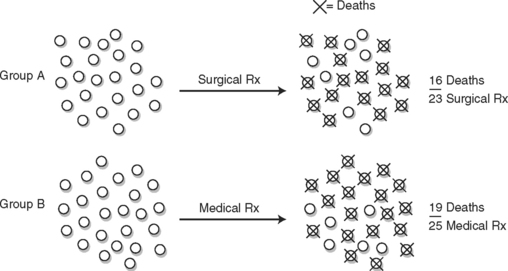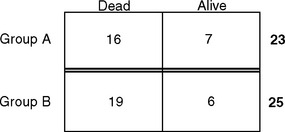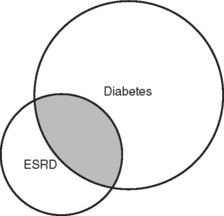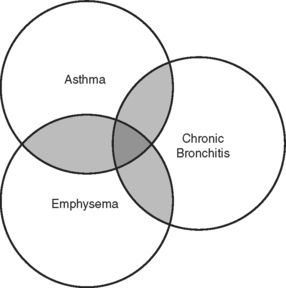CHAPTER 2 Mathematical Principles
RATIOS
D reflects the number of subjects in the group, such as the number of subjects getting standard medical treatment. N is the number of subjects with the characteristic being measured in the group, such as mortality. Figure 2-1 illustrates the results of a study where subjects with lung cancer received either medical or surgical treatment and mortality rates were compared.
For example, group A had 16 deaths out of 23 individuals in 5 years. Group B had 19 deaths out of 25 individuals in the same time period. Which group fared worse?
Group B did worse; they had a higher death rate.
Again, we see that group B had a higher mortality rate.
Group A had a 70% mortality rate, whereas Group B had a 76% mortality rate.
LOGIC AND VENN DIAGRAMS
Certain groups of individuals tend to have associated characteristics. For instance, people with diabetes tend to have end-stage renal disease (ESRD) requiring dialysis. But not all people on dialysis have diabetes, and not all diabetics have renal failure. These relationships can be expressed graphically as Venn diagrams, where one circle represents condition 1 and another circle represents condition 2. An example of a Venn diagram is shown in Figure 2-2. These are rough diagrams that do not have numerical meaning, but the relative sizes of the circles are often a crude estimate of the relative prevalence of the conditions. The overlap represents those subjects with both conditions.
Venn diagrams do not need to be limited to two conditions. For example, Figure 2-3 illustrates the relationship between asthma, chronic bronchitis, and emphysema. Some people have just one of these conditions, others have two, and the ones represented in the middle of the diagram have been diagnosed with all three. This Venn diagram also illustrates that none of these conditions is exclusive. The presence of one condition does not exclude the possibility of having another.
Venn diagrams are used to illustrate an early awareness between connected conditions. As one circle encroaches upon another or the overlap increases, we may be prompted to perform further observational tests to try to quantify that relationship. In fact, as we continue to learn more about diseases and their epidemiology, such Venn diagrams are revised.
When one circle is completely within another bigger circle, as in Figure 2-4
Stay updated, free articles. Join our Telegram channel

Full access? Get Clinical Tree



















